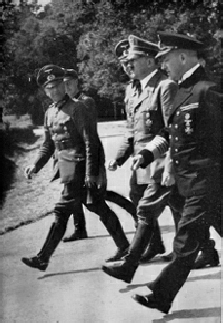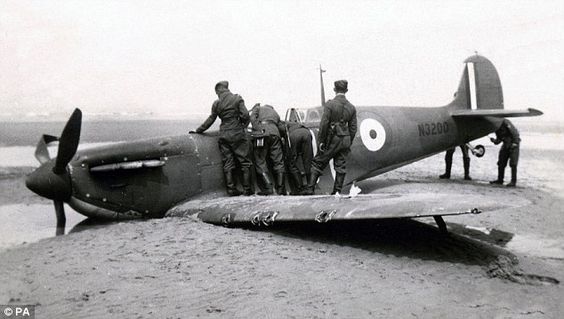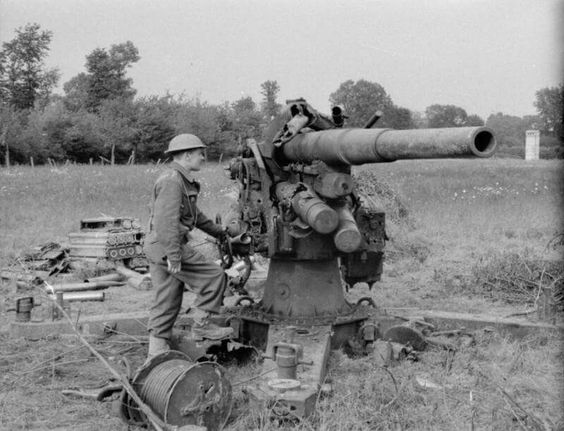Friday 28 June 1940
 |
| The Luftwaffe's bombing by three planes of Weighbridge, St. Peter Port, Guernsey, on 28 June 1940. |
U-30 (Kapitänleutnant Fritz-Julius Lemp) torpedoes and sinks 5,053 ton British ship Llanarth 250 miles west of Ushant, France at 0200 hours. All 35 aboard survive: 16 crew wind up on British corvette HMS “Gladiolus” on June 30, 19 others are picked up by a Spanish trawler.
Convoy HG 36 departs from Gibraltar.
Battle of the Mediterranean: Five British cruisers intercept the Italian destroyers Espero, Zeffiro and Ostro as they carry supplies to Tobruk. They sink the Espero. Royal Navy cruiser HMS Liverpool suffers damage from a shell which destroys its degaussing wire, leaving it vulnerable to magnetic mines.
Air raids on Malta continue. Malta continues to be an important refueling stop for Sunderland flying boats operating between London and Cairo.
British flying boats sink Italian submarine Anfitrite.
The Admiralty confirms that it is unable to send convoys to Malta via Gibraltar. Supplies remain possible via the perilous route from the Suez Canal. Malta is seriously short of supplies such as sandbags, goat fodder, coke, coal, and medical supplies. Malta requests this from Cairo, and the problem is only going to get worse. The island is projected to need 23,000 tons of supplies for the army, 10,000 for the dockyards, and 2000 for the RAF.
Battle of the Pacific: In response to Australian calls for an increased naval presence in the western Pacific, the British refuse to send any ships. They blame the Italian entry to the war.
 |
| The church clock stopped at 19:00 hrs when the Luftwaffe bombed Guernsey. |
The RAF continues its raids on Holland, blowing up ammunition stocks at Willemoord. It also sends 20 bombers against Merville airfield in France.
Douglas Bader becomes commanding officer of No. 242 Squadron, based at RAF Coltishall at Norwich.
Western Front: The British cabinet decides that the Channel Islands, very close to France, are indefensible. The British government demilitarizes them and evacuates 26,700 inhabitants who wish to avoid German occupation. A large fraction of the population, however, remains.
Mussolini and Badoglio tour the area occupied by Italian troops during the brief conflict with France. It is a short tour.
Soviet/Romanian Relations: Soviet paratroopers and armored formations of General Zhukov's Kyiv Special Military District begin entering Bessarabia and Northern Bukovina without waiting for the end of the minimal grace period granted by Molotov.
The Soviets also occupy the Hertza Region, part of the Romanian Old Kingdom, which was not part of the ultimatum. There are armed clashes and some casualties, but the Romanians withdraw. Romania responds by ordering a general mobilization.
The pretext for the invasion is liberating ancestral Russians from foreign domination. The liquidation squads follow the troops, armed with lists of "subversives" such as lawyers, doctors, and teachers. One of the goals is swiftly accomplished: blowing up churches.
Anglo/French Relations: In line with gradual but inexorable British distancing from the current French government in Bordeaux, the British government formally recognizes Charles de Gaulle as the leader of the Free French. He is not quite a government-in-exile, but the closest thing that there is to one.
Admiral Decoux and General Catroux meet with British Admiral Sir Percy Noble in Saigon to discuss any assistance that the British might be able to offer against the Japanese. Sir Percy says none is available.
 |
| French soldiers surrendering at the Place de Jaude in Clermont-Ferrand, France on 21 June 1940. The Germans leave the town, which under the terms of the Armistice remained French, on 28 June 1940. |
British Blenheim bombers attack Tobruk.
The Regia Aeronautica raids the British base at Mersa Matruh.
The Italians attack a small British garrison of the King's African Rifles at Moyale on the Kenyan/Ethiopian border, with inconclusive military results.
British General Wavell visits French General Mittelhauser in the Levant. The latter confirms that he continues to report to the French government in Bordeaux.
Albanian Government: Exiled King Zog and his family settle in London.
French Government: Former French Prime Minister Paul Reynaud is injured in an auto accident near Bordeaux. His mistress, Countess de Portes, a strong voice against further French resistance, perishes.
British Government: Prime Minister Winston Churchill declines an offer to make a radio broadcast in the United States, noting that only events, not words, will move public opinion for good.
US Government: President Roosevelt signs the Smith Act aka The Alien Registration Act of 1940. It requires non-citizen adult aliens to register with the government and makes it unlawful for anyone to advocate or teach the overthrow or destruction of any U.S. government by force or violence or to be a member of a group that advocated such goals.
"Wild Bill" Donovan buttonholes Allen Dulles at the Republican National Convention and begins working him to join the organization that will turn into the OSS.
Vatican: Pope Pius XII offers to mediate, which he has done before secretly. Nobody takes him up on his offer. Winston Churchill tartly responds: "We desire no inquires as to peace term with Hitler."
American Homefront: The Republicans nominate Wendell Willkie as their candidate for the upcoming Presidential campaign. Charles L. McNary of Oregon is the VP pick. He states:
“I stand before you without a single pledge or promise or understanding of any kind except for the advancement of your cause and the preservation of American democracy."
 |
| Wendell Wilkie accepts the Republican nomination for President. |
June 1940
June 1, 1940: Devastation at Dunkirk
June 2, 1940: Hitler Visits France
June 3, 1940: Operation Paula
June 4, 1940: We Shall Fight
June 5, 1940: Fall Rot
June 6, 1940: Weygand Line Crumbling
June 7, 1940: British Evacuating Narvik
June 8, 1940: Operation Juno
June 9, 1940: Norway Capitulates
June 10, 1940: Mussolini Throws Down
June 11, 1940: Paris an Open City
June 12, 1940: Rommel at St. Valery
June 13, 1940: France Goes Alone
June 14, 1940: Paris Falls
June 15, 1940: Soviets Scoop Up Lithuania
June 16, 1940: Enter Pétain
June 17, 1940: The Lancastria Sinks
June 18, 1940: A Day of Leaders
June 19, 1940: U-boats Run Wild
June 20, 1940: Pétain Wilts
June 21, 1940: Hitler's Happiest Day
June 22, 1940: France Is Done
June 23, 1940: Hitler in Paris
June 24, 1940: Six Million Jews
June 25, 1940: German Celebrations
June 26, 1940: USSR Being Belligerent
June 27, 1940: Malta in Peril
June 28, 1940: Channel Islands Bombed
June 29, 1940: Gandhi Insists on Independence
June 30, 1940: Channel Islands Occupied
2020













